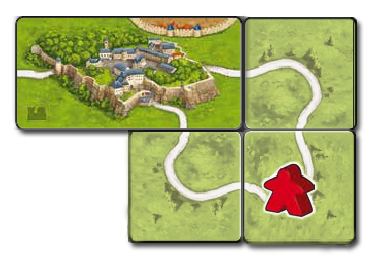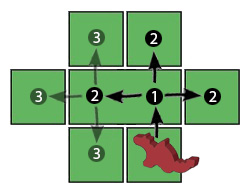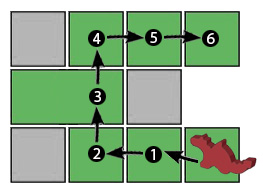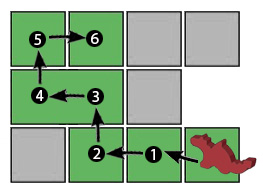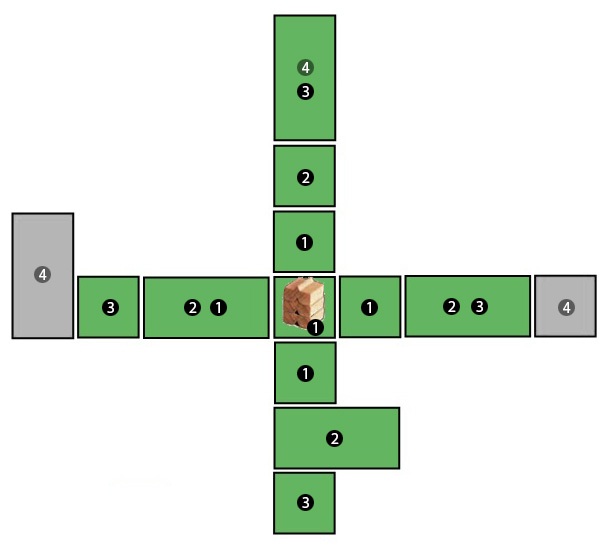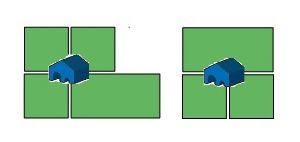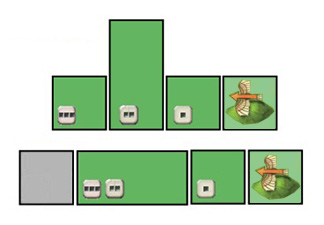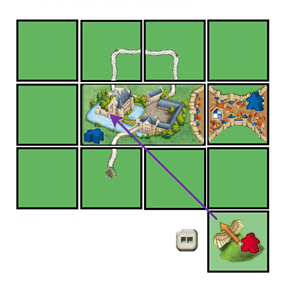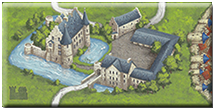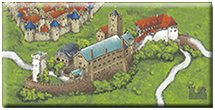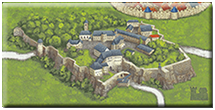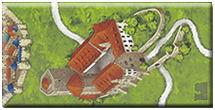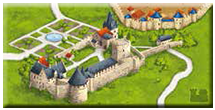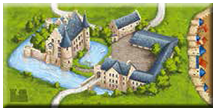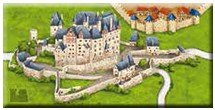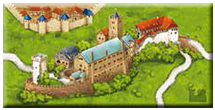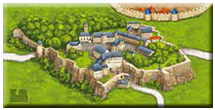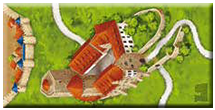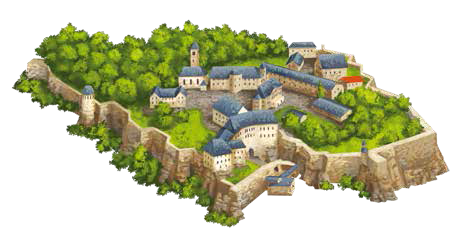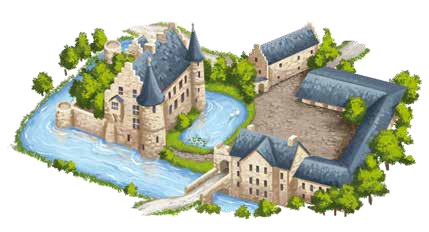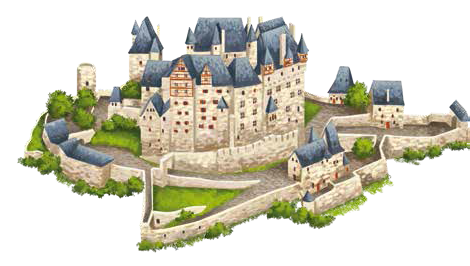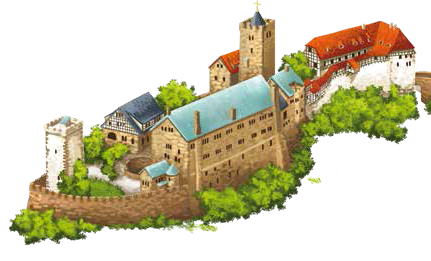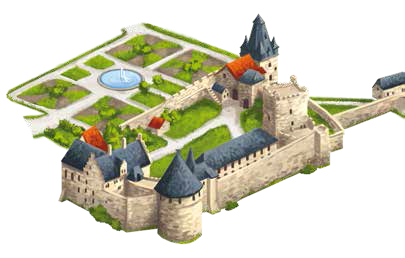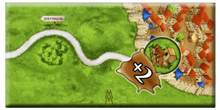Castles in Germany
 |
You are reading the rules for this tile design. |
 | Read the following rules if your tiles look like this. |
| If your tiles have a different design, then choose a game from Spin-offs. |  |
This mini-expansion, featuring 6 well-known castles in Germany, allows the players to become lords and ladies, earning extra points for their famous estates.
General info and comments
Castles in Germany (Burgen in Deutschland) was released in C2 (the 2nd edition) by Hans im Glück in 2019. A C3 (the third edition) version was released in 2022, which has cities with clipped buildings.
The 1st print of this expansion in C3 was sold in shrink wrap, the same as in previous editions. The 2nd print in C3, from 2024, came in a paper envelope.
This mini expansion was originally released in C1 (the 1st edition) in 2015.
Contents
- 6 double-size landscape tiles depicting German castles
Rules
Preparation
Each player picks one castle of his choice. When you play as two or three players you can take 2 castles each. Alternatively, you may shuffle the castle tiles and deal them out. Then, you place your Castle tiles face up in front of you. [1]
Gameplay
1. Placing a tile
Instead of taking a Land tile from the draw pile players are allowed to place one of their castles. Note that a Castle tile must not touch another Castle tile, neither directly nor with the edges (diagonally). All other placing rules stay the same as in the basic game.
2. Placing a meeple
Having placed their Castle tile, players are allowed to place a meeple. They may place the meeple on a road, city, or field or as lord in the castle.
3. Scoring a feature
Scoring of a completed castle
A castle can be completed and scored the same way as monasteries. As soon as the castle is surrounded by other Land tiles, you, the lord gets 12 points and take your meeple back to your stash.
At the end of the game all Land tiles surrounding an incomplete castle score one point. The Castle tile itself counts as 2 points.
Scoring roads and cities around a castle
If a road or a city which ends on the Castle tile is completed, players get bonus points. Each player who gets points gets 3 bonus points for each castle which is involved. [2] [3] It does not make any difference if the castle is occupied or not.
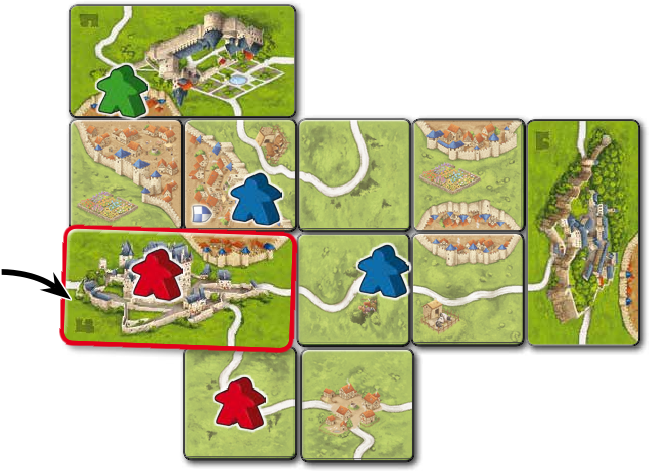
- You place the castle in the bottom left corner and place a meeple inside on it. You complete 2 roads and 1 city by doing that.
- Green and Blue get 16 points for their city. (10 points for the city and 2 x 3 points for the castles)
- You get 6 points for your road (3 points for the road and 3 points for the castle)
- Blue gets 10 points for his road (4 points for the road and 2 x 3 points for the castles)
Additional clarifications
![]() Roads: Roads looping back to a German castle will consider the two square spaces occupied by the double-sized tile separately. [4]
Roads: Roads looping back to a German castle will consider the two square spaces occupied by the double-sized tile separately. [4]

![]() Monasteries: Since monasteries are scored according to the occupied spaces by the monastery itself and its adjacent spaces, a German castle tile counts as the number of spaces it occupies: 1 or 2 depending of its placement relative to the monastery.
Monasteries: Since monasteries are scored according to the occupied spaces by the monastery itself and its adjacent spaces, a German castle tile counts as the number of spaces it occupies: 1 or 2 depending of its placement relative to the monastery.
![]() Question: Can we assume that monasteries A and B also score 9 points?
Question: Can we assume that monasteries A and B also score 9 points?
Answer: Yes, it's also 9 points. For each occupied space around the monastery 1 point (8 points) and 1 point for the monastery itself. (1/2021)
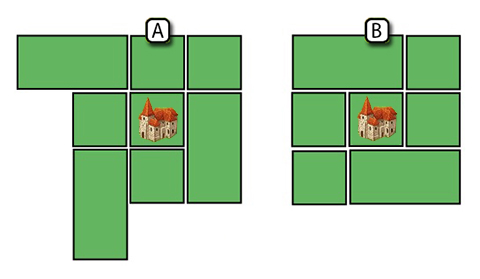
- Example A: This completed monastery scores 9 points, with 3 German castles in its vicinity.
- Example B: This completed monastery scores 9 points, with 2 German castles in its vicinity.
Final Scoring
At the end of the game there aren't any bonus points for cities or roads.
![]() Question: Does a German castle count for field scoring?
Question: Does a German castle count for field scoring?
Answer: No, it doesn't count for field scoring. The German castle is on one tile, so its has less functions than a castle that sits between two tiles. (10/2015)
Other expansions
This section contains additional information about the interactions with other Carcassonne expansions.
![]() This section covers clarifications regarding the interaction of German castles with other expansions (from 10/2015, later updated in 1/2021)
This section covers clarifications regarding the interaction of German castles with other expansions (from 10/2015, later updated in 1/2021)
![]() Question: How should we consider double-sized tiles for towers and flying machines?
Question: How should we consider double-sized tiles for towers and flying machines?
Answer: Even if it is a double tile, you simply count the spaces (areas). A double tile still consists of 2 spaces. Therefore it doesn't matter if you use double-sized tiles or normal tiles for the tower, flying machine or a dragon, the "range" stays the same. (1/2021)
![]() Question: Should we consider that we should always count spaces (areas) and not tiles, and then consider any tiles in that space if more than one or part of one?
Question: Should we consider that we should always count spaces (areas) and not tiles, and then consider any tiles in that space if more than one or part of one?
Answer: Yes exactly. For example, a dragon could walk 2 steps on a double-sized tile, but if it is a German castle, it would already eat the meeple on his first step on the tile. (1/2021)
![]() Exp. 1 - Inns & Cathedrals - Bonus Points
Exp. 1 - Inns & Cathedrals - Bonus Points
![]() Scoring first takes place for roads with an inn or a city with a cathedral, and then the +3 bonus from any German castle is added.
Scoring first takes place for roads with an inn or a city with a cathedral, and then the +3 bonus from any German castle is added.
![]() Exp. 3 - The Princess & the Dragon - Dragon movement
Exp. 3 - The Princess & the Dragon - Dragon movement
![]() German castles do not protect meeples from the dragon. The German castle is on one tile, so it has less functions than a castle (from
German castles do not protect meeples from the dragon. The German castle is on one tile, so it has less functions than a castle (from ![]() Exp. 8 - Bridges, Castles & Bazaars) that sits between 2 tiles. The function or the mechanics of the German castle is more like those of a monastery.
Exp. 8 - Bridges, Castles & Bazaars) that sits between 2 tiles. The function or the mechanics of the German castle is more like those of a monastery.
![]() The German castle tile is one single tile but it represents two spaces for the movement of the dragon. The dragon affects the whole tile when it lands on it, but it may represent two steps in its movement.
The German castle tile is one single tile but it represents two spaces for the movement of the dragon. The dragon affects the whole tile when it lands on it, but it may represent two steps in its movement.
![]() Exp. 4 - The Tower - Tower range
Exp. 4 - The Tower - Tower range
![]() German castles count as one tile for the tower, but they represent two spaces for the tower range. If at least one of the spaces occupied by a German castle tile is in range from the tower, any meeple placed on the tile can be captured.
German castles count as one tile for the tower, but they represent two spaces for the tower range. If at least one of the spaces occupied by a German castle tile is in range from the tower, any meeple placed on the tile can be captured.
![]() Exp. 5 - Abbey & Mayor - Part 1: Wagon movement
Exp. 5 - Abbey & Mayor - Part 1: Wagon movement
![]() The wagon can be placed on a German castle.
The wagon can be placed on a German castle.
![]() The wagon can be driven to an uncompleted, unoccupied German castle from any feature completed on the German castle tile or any of its 10 possible adjacent tiles.
The wagon can be driven to an uncompleted, unoccupied German castle from any feature completed on the German castle tile or any of its 10 possible adjacent tiles.
![]() The wagon can be driven from a completed German castle to any uncompleted, unoccupied feature on the German castle tile or any of its 10 possible adjacent tiles.
The wagon can be driven from a completed German castle to any uncompleted, unoccupied feature on the German castle tile or any of its 10 possible adjacent tiles.
![]() Exp. 5 - Abbey & Mayor - Part 2: Barn Placement
Exp. 5 - Abbey & Mayor - Part 2: Barn Placement
![]() The general rule states that the base for the barn has to be stable - that means that the corner of all four tiles have to touch each other and all tiles must have field in the corner for the placement of the barn.
The general rule states that the base for the barn has to be stable - that means that the corner of all four tiles have to touch each other and all tiles must have field in the corner for the placement of the barn.
![]() A German castle tile can therefore occupy one or two of the corners under the barn.
A German castle tile can therefore occupy one or two of the corners under the barn.
![]() Exp. 8 - Bridges, Castles & Bazaars - Castles
Exp. 8 - Bridges, Castles & Bazaars - Castles
![]() You can build a small city including the semicircular city segment on a German castle tile. If this small city is converted into a castle, neither the small city at that point nor the castle, if scored, will receive bonus points for the German castle.
You can build a small city including the semicircular city segment on a German castle tile. If this small city is converted into a castle, neither the small city at that point nor the castle, if scored, will receive bonus points for the German castle.
![]() Mini #1 - The Flying Machines - Flier distance and placement
Mini #1 - The Flying Machines - Flier distance and placement
![]() The German castle counts as 1 tile occupying two spaces. The flier considers spaces for its movement. If the flier lands on a space occupied by a German castle, it can choose any feature on the whole tile, that is, the flier has the choice of 3 roads, 1 city or the German castle (the function or the mechanics of the German Castle is more like those of a monastery.) The flier can only land on one of these features if it is not yet finished.
The German castle counts as 1 tile occupying two spaces. The flier considers spaces for its movement. If the flier lands on a space occupied by a German castle, it can choose any feature on the whole tile, that is, the flier has the choice of 3 roads, 1 city or the German castle (the function or the mechanics of the German Castle is more like those of a monastery.) The flier can only land on one of these features if it is not yet finished.
![]() If the flight of the flier is diagonal, all steps must be in a straight line in the direction the arrow shows from the flying machine tile. The angle cannot change but it would if it had entered via one corner of the German castle tile, and exited via the opposite corner. If the flier lands on the German castle tile then the flier has the choice of 3 roads, 1 city or the German Castle. The flier can only land on one of these features if it is not yet finished.
If the flight of the flier is diagonal, all steps must be in a straight line in the direction the arrow shows from the flying machine tile. The angle cannot change but it would if it had entered via one corner of the German castle tile, and exited via the opposite corner. If the flier lands on the German castle tile then the flier has the choice of 3 roads, 1 city or the German Castle. The flier can only land on one of these features if it is not yet finished.
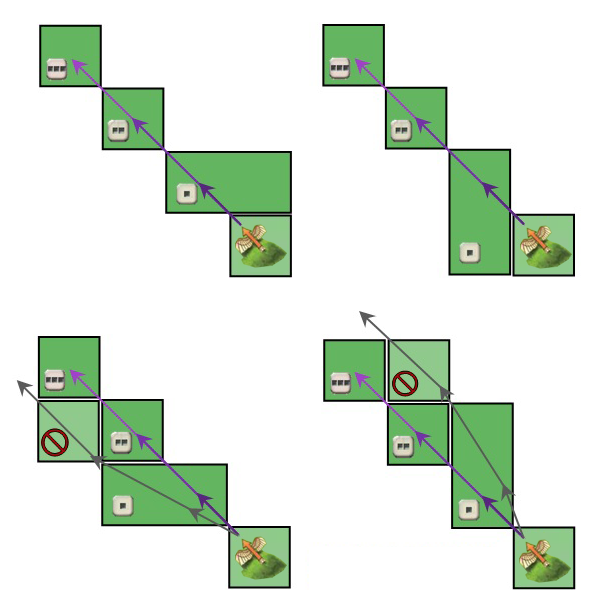 Example F2: These examples show a diagonal flier trajectory involving German castle tiles. The violet arrow indicates the correct trajectory following the flying machine direction. The grey arrow shows an invalid diagonal trajectory as it deviates from the trajectory indicated by the flying machine.
Example F2: These examples show a diagonal flier trajectory involving German castle tiles. The violet arrow indicates the correct trajectory following the flying machine direction. The grey arrow shows an invalid diagonal trajectory as it deviates from the trajectory indicated by the flying machine.
![]() The Plague - Plague spreading
The Plague - Plague spreading
![]() A German castle counts as 1 tile for the plague tokens, but two spaces for its movement. See the example with the dragon above.
A German castle counts as 1 tile for the plague tokens, but two spaces for its movement. See the example with the dragon above.
![]() Monasteries in Germany /
Monasteries in Germany / ![]() Monasteries in the Netherlands & Belgium /
Monasteries in the Netherlands & Belgium / ![]() Japanese Buildings - Scoring with a meeple placed as an abbot
Japanese Buildings - Scoring with a meeple placed as an abbot
![]() Double-sized tiles will be considered as two square spaces when scoring of the abbot on a special monastery. Special monasteries will count those square spaces in the columns and rows starting from the monastery tile.
Double-sized tiles will be considered as two square spaces when scoring of the abbot on a special monastery. Special monasteries will count those square spaces in the columns and rows starting from the monastery tile.
- Depending on the position of a German monastery tile overlapping any of those rows or columns, only one or both square spaces of a double-sized tile will be taken into consideration for the scoring. [5]
![]() The Watchtowers - Scoring
The Watchtowers - Scoring
![]() A watchtower scoring for roads or cities will consider the features on each half of a double-sized tile separately. [6]
A watchtower scoring for roads or cities will consider the features on each half of a double-sized tile separately. [6]
![]() A watchtower scoring for meeples will consider all the meeples on double-sized tiles adjacent to them, even if one of their halves is not actually adjacent.
A watchtower scoring for meeples will consider all the meeples on double-sized tiles adjacent to them, even if one of their halves is not actually adjacent.
![]() Question: If a watchtower scoring for meeples is adjacent to only one half of a double-sized tile, does the watchtower consider those meeples on the half adjacent to the watchtower or all the meeples on the tile?
Question: If a watchtower scoring for meeples is adjacent to only one half of a double-sized tile, does the watchtower consider those meeples on the half adjacent to the watchtower or all the meeples on the tile?
Answer: The watchtower will consider all the meeples on the double-sized tile. (10/2022)
Tile distribution
Third edition C3
Second edition C2
The castles in detail
Königstein Fortress (Saxony)
This castle is one of Europe's biggest hilltop fortresses. It is situated in Saxon Switzerland in the Elbe Sandstone Mountains near Dresden. The fortress was built on top of a rock plateau 240 meters above the river Elbe. Over a period of more than 750 years, this place became an impressive ensemble of buildings of the late gothic period, the renaissance, the baroque and the 19th century.
http://www.festung-koenigstein.de
Konradsheim Castle (North Rhine-Westphalia)
This water castle is situated between Cologne and Bonn and is one of the few castles of the late Middle Ages in the Rhineland still preserved. The knight Arnold von Buschfeld is said to be the builder of this castle. First mentioned in a document in 1337, the castle is nowadays private property and can be rented for events.
http://www.burg-konradsheim.de
Rieneck Castle (Bavaria)
This castle was built around 1150 near the town of Rieneck above the river Sinn in Lower Franconia in Bavaria. Today, the castle serves as a scouting facility and is owned by the German Christian Guide and Scout Association. Particularly well known – and the centrepiece of the castle – is the “Thick Tower“ built in the 12th century with his romantic wall chapel constructed completely enclosed by the keep's wall.
http://www.burg-rieneck.de
Eltz Castle (Rhineland-Palatinate)
It is considered the paragon of German castles. It is situated in the Eltz river valley near the Eifel. It was built in the beginning of the 12th century and has yet never been destroyed. Eltz castle has a history full of myths, luminaries and distinguished art.
http://www.burg-eltz.de
Wartburg Castle (Thuringia)
The Wartburg (Burg: german castle) is situated above the city of Eisenach in Thuringia. Built around 1067 under Louis the Springer ("the Jumper") the castle is – since 1999 – a UNESCO World heritage site. Between May 1521 and March 1522 Martin Luther, who had found shelter inside the Wartburg, translated the New Testament into German.
http://www.wartburg.de
Bentheim Castle (Lower Saxony)
This is a castle complex in the middle of the city of Bad Bentheim in Lower Saxony, which has been built in the Early Middle Ages. First mentioned in a document in the 11th century it is believed to be one of the largest and most beautiful castle complexes in north-western Germany. Nowadays, the castles museum can be visited year-round.
http://www.burg-bentheim.de
Footnotes
For Icons explanation and licensing please visit Icons page.
- ↑
 The Castle tiles remain visible to all the players once distributed. The German rules state that players place the Castle tiles face up. The English rules do not mention this explicitly.
The Castle tiles remain visible to all the players once distributed. The German rules state that players place the Castle tiles face up. The English rules do not mention this explicitly.
- ↑
 Thus, a road that had each end on a different castle tile would score 6 bonus points. A road that began and ended on the same castle tile would receive 3 bonus points. (4/2015)
Thus, a road that had each end on a different castle tile would score 6 bonus points. A road that began and ended on the same castle tile would receive 3 bonus points. (4/2015)
- ↑
 These bonus points are added to the feature score after modifications from inns or cathedrals. (10/2015)
These bonus points are added to the feature score after modifications from inns or cathedrals. (10/2015)
- ↑
 The long road segments on the Leipzig tiles are an edge case in C2, where they are counted as one tile. In C3, the long road segments are counted as two tiles. (See
The long road segments on the Leipzig tiles are an edge case in C2, where they are counted as one tile. In C3, the long road segments are counted as two tiles. (See  The Markets of Leipzig)
The Markets of Leipzig)
- ↑
 This approach is based on the clarifications provided for The Markets of Leipzig (see FAQ boxes here).
This approach is based on the clarifications provided for The Markets of Leipzig (see FAQ boxes here).
- ↑
 This is a consequence of a similar official clarification for (haunted) castles and the mist banks on the 2x2 starting tile in
This is a consequence of a similar official clarification for (haunted) castles and the mist banks on the 2x2 starting tile in  Exp. 11 - Ghosts, Castles & Cemeteries.
Exp. 11 - Ghosts, Castles & Cemeteries.







